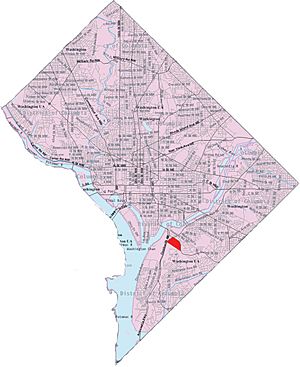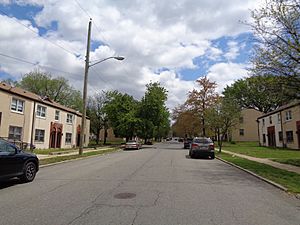Barry Farm facts for kids
Quick facts for kids
Barry Farm
|
|
|---|---|
|
Neighborhood of Washington, D.C.
|
|

Barry Farm within the District of Columbia
|
|
| Country | United States |
| District | Washington, D.C. |
| Ward | Ward 8 |
Barry Farm is a neighborhood in Southeast Washington, D.C.. It is located east of the Anacostia River. The neighborhood is bordered by the Southeast Freeway to the northwest. Suitland Parkway is to the northeast and east. St. Elizabeths Hospital is to the south.
Barry Farm became famous after the American Civil War. It was a special place where free Black people and formerly enslaved people settled. The Freedmen's Bureau helped create this community. Many streets in Barry Farm are named after important people. These include Union generals and politicians who supported the rights of Black Americans. For example, Howard Road SE is named for General Oliver Otis Howard. Sumner Road SE is for Senator Charles Sumner. The neighborhood's name is not connected to former mayor Marion Barry.
Contents
History of Barry Farm
A New Start for Freed People
In 1867, the Freedmen's Bureau bought a large farm. It was 375 acres and belonged to Julia Barry. The Bureau helped turn Barry Farm into a new community. This was for African Americans who were once enslaved or born free.
General Oliver Otis Howard, who led the Freedmen's Bureau, asked Black people in Washington, D.C., what they needed. They said, "Land! Give us land!" Howard promised to find land near the city. He used money from a special fund to buy Barry Farm.
The Bureau divided the farm into one-acre plots. Formerly enslaved people could buy these plots over seven years. For a bit more money, they could also buy wood to build a house. This helped many families start new lives.
How the Neighborhood Changed
Barry Farm was originally a very large area. It stretched far to the east and west. In 1871, a part of Barry Farm became a new area called Hillsdale.
Later, new roads and tracks were built. Around 1913, railroad tracks cut off Barry Farm from Poplar Point. In the 1940s, the Suitland Parkway was built. This road was first a military highway. It caused nearly 100 houses to be torn down. More than 600 people had to move.
Later, I-295 (the Anacostia Freeway) was built. This made it harder to reach the Anacostia River. Today, only a few old houses remain from the original community. In 1943, the National Capital Housing Authority built the Barry Farm Dwellings. This was a public housing project with 442 homes.
Community Spirit and Activism
People in Barry Farm have always worked together. They organized to get help from the city. They also supported each other.
Fighting for Equal Schools
In the 1940s, there were not many schools for African American students. Especially east of the Anacostia River. In 1950, residents of Barry Farm Dwellings asked for their children to attend Sousa Junior High. This school was only for white students. They wanted the school to be integrated.
Their complaint became part of a famous court case called Bolling v. Sharpe. This case was heard alongside Brown v. Board of Education. In 1954, the U.S. Supreme Court made a big decision. They said that separate schools for different races were unfair. They were against the law. Several families from Barry Farm were involved in this important fight for equal education.
Working Together for Change
In the 1960s, new groups formed to help tenants. One group was called the Band of Angels. It was led by women like Lillian Wright and Etta Mae Horn. Their first big success was getting $1.5 million to fix up the Barry Farm Dwellings. Etta Horn later became an important leader in civil rights.
Sports and Food in the Community
Since 1975, Barry Farm has been home to the Barry Farms Community Basketball League. This summer league is now called the Goodman League. It is named after George Goodman, a community activist. Famous NBA players and college players often play in this league. The Barry Farm Beavers football team also plays at the recreation center.
In 1982, residents started a food co-op. This co-op helped people get food. It even accepted food stamps. Later, in 1997, a community farm was started with the help of residents.
Famous People from Barry Farm
Many notable people have lived in Barry Farm:
- Solomon G. Brown was the first African American employee at the Smithsonian Institution. He worked there for 54 years.
- Emily Edmonson was a founder of the Hillsdale community. In 1848, she and her sister Mary tried to escape slavery. They were part of the Pearl incident, where 77 enslaved people tried to sail to freedom.
- Etta M. Horn was a key leader in the Welfare Rights Movement. She helped organize the Band of Angels. This group successfully pushed for renovations at Barry Farm.
- Several families who fought for school desegregation lived in Barry Farm Dwellings. These include the Jennings, Briscoe, Cogdell, Morris, Parker, and Bolling families.
- The Junk Yard Band is a go-go band. It was started in the early 1980s right in Barry Farm Dwellings.
The Future of Barry Farm
Changes and Challenges
The city of Washington, D.C., began a plan to change Barry Farm. This plan is called the New Communities Initiative. It also uses the Federal Choice program. The goal was to rebuild Barry Farm from public housing into a mixed-use community. This means having different types of homes, including some for sale. The plan aimed for 1,600 new homes.
Standing Up for Their Homes
In 2013, about 50 Barry Farm residents formed a group. It was called the Barry Farm Tenants and Allies Association. They worked with Empower DC. Their goal was to stop the city from making them leave their homes too soon. They also wanted to make sure the new community would have enough green space. Most importantly, they wanted to guarantee their right to return to the new homes.
From 2018 to 2019, many families moved from Barry Farm. Demolition of the old buildings began in early 2019. The Barry Farm Tenants and Allies Association had a big success. They got five public housing buildings declared as historic landmarks. These buildings were home to important activists. As of 2022, these buildings and a recreation center were the only ones left on the site.
Images for kids










